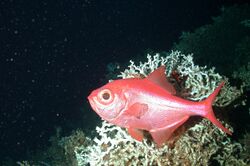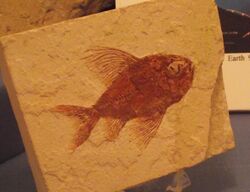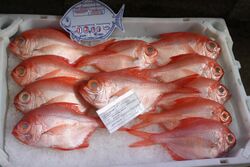Biology:Beryciformes
| Beryciformes | |
|---|---|

| |
| Beryx decadactylus | |
| Scientific classification | |
| Domain: | Eukaryota |
| Kingdom: | Animalia |
| Phylum: | Chordata |
| Class: | Actinopterygii |
| Superorder: | Acanthopterygii |
| Order: | Beryciformes Regan, 1909 |
| Type species | |
| Beryx decadactylus[1] (G. Cuvier, 1829)
| |
| Families | |
| |
| Synonyms | |
| |
The Beryciformes /ˈbɛrɪsɪfɔːrmiːz/ are a poorly-understood order of carnivorous ray-finned fishes consisting of 7 families, 30 genera, and 161 species.[2] They feed on small fish and invertebrates. Beyond this, little is known about the biology of most member species because of their nocturnal habits and deepwater habitats.[3] All beryciform species are marine and most live in tropical to temperate, deepwater environments. Most live on the continental shelf and continental slope, with some species being found as deep as 2,000 m (6,600 ft).[4] Some species move closer to the surface at night,[5] while others live entirely in shallow water and are nocturnal, hiding in rock crevices and caves during the day. Several species are mesopelagic and bathypelagic. Beryciformes' bodies are deep and mildly compressed, typically with large eyes that help them see in darker waters. Colors range from red to yellow and brown to black, and sizes range from 8–61 cm (3.1–24.0 in).[4] Member genera include the alfonsinos, squirrelfishes, flashlight fishes, fangtooth fishes, spinyfins, pineconefishes, redfishes, roughies, and slimeheads. A number of member species are caught commercially, including the alfonsino, the splendid alfonsino, and the orange roughy, the latter being much more economically important. Some species have bioluminescent bacteria contained in pockets of skin or in light organs near the eyes, including the anomalopids and monocentrids.[3]
Taxonomy and phylogeny

Beryciforms first appeared during the Late Cretaceous period and have survived to today in relative abundance. They are considered the most primitive order in Acanthopterygii, and as such are split off at the base of the cladogram below from the rest of the member orders. Beryciforms are distinguished by having 18–19 caudal fin rays, as opposed to percomorphs, which have 17. Having fewer caudal fin rays is considered a sign of a more recently evolved species among fish. The whalefishes, beardfishes, gibberfishes, and pricklefishes were once considered members of Beryciformes, but have since been assigned to separate orders.[3]
A recent phylogeny based on the work Betancur-Rodriguez et al. 2017.[6] The Gibberichthyidae (gibberfishes) and Hispidoberycidae (spiny-scale pricklefish) of suborder Stephanoberycoidei were not examined.
| ||||||||||||||||||||||||||||||||||||||||||||||||||||||||||||||||||||||||||||
Older classification
The order contains 7 families, 30 genera, and 161 species:[2]
- Order Beryciformes
- Suborder Berycoidei
- Berycidae (alfonsinos, nannygais)
- Suborder Holocentroidei
- Holocentridae (soldierfishes, squirrelfishes)
- Suborder Trachichthyoidei
- Anomalopidae (flashlight fishes, lanterneye fishes)
- Diretmidae (spinyfins)
- Monocentridae (pineconefishes, pineapple fishes)
- Trachichthyidae (incl. Anoplogastridae)(slimeheads, redfishes, roughies, fangtooth fishes)
- Suborder Berycoidei
- Order Cetomimiformes
- Family Rondeletiidae (redmouth whalefishes)
- Family Barbourisiidae (red/velvet whalefishes)
- Family Cetomimidae (flabby whalefishes)
- Order Stephanoberyciformes
- Family Melamphaidae (bigscale fishes)
- Family Gibberichthyidae (gibberfishes)
- Family Hispidoberycidae (Spiny-scale pricklefishes)
- Family Stephanoberycidae (pricklefishes)
Human interaction

The Beryciformes are generally not important to humans, and their trend towards living in deeper waters generally keeps many species away from human activity. Several species are found in the aquarium trade, however. Pineapplefishes are of interest to fishkeepers for their bright colors, while squirrelfishes' shallower reef habitats and bright red colors make them more easily collected. Flashlight fishes are also kept as pets because of the bioluminescent organs underneath their eyes.[3] The alfonsinos and orange roughy are of a different interest to humans, targeted by deepwater commercial fisheries. Increased catches could lead to steep population declines for these species as their extended lifespans make them vulnerable to overfishing. The orange roughy, for example, can live up to 149 years, but takes anywhere from 23 to 40 years to begin reproducing.[7][8] Despite these risks, most of the species that have been evaluated by the International Union for Conservation of Nature (IUCN) are listed as Least Concern or Data Deficient; only a few are classified as Vulnerable.
Timeline of genera
The Beryciformes first appeared in the Late Cretaceous and still survive today in relative abundance.[9] <timeline> ImageSize = width:1000px height:auto barincrement:15px PlotArea = left:10px bottom:50px top:10px right:10px
Period = from:-145.5 till:15 TimeAxis = orientation:horizontal ScaleMajor = unit:year increment:10 start:-145.5 ScaleMinor = unit:year increment:1 start:-145.5 TimeAxis = orientation:hor AlignBars = justify
Colors =
#legends id:CAR value:claret id:ANK value:rgb(0.4,0.3,0.196) id:HER value:teal id:HAD value:green id:OMN value:blue id:black value:black id:white value:white id:cretaceous value:rgb(0.5,0.78,0.31) id:earlycretaceous value:rgb(0.63,0.78,0.65) id:latecretaceous value:rgb(0.74,0.82,0.37) id:cenozoic value:rgb(0.54,0.54,0.258) id:paleogene value:rgb(0.99,0.6,0.32) id:paleocene value:rgb(0.99,0.65,0.37) id:eocene value:rgb(0.99,0.71,0.42) id:oligocene value:rgb(0.99,0.75,0.48) id:neogene value:rgb(0.999999,0.9,0.1) id:miocene value:rgb(0.999999,0.999999,0) id:pliocene value:rgb(0.97,0.98,0.68) id:quaternary value:rgb(0.98,0.98,0.5) id:pleistocene value:rgb(0.999999,0.95,0.68) id:holocene value:rgb(0.999,0.95,0.88)
BarData=
bar:eratop bar:space bar:periodtop bar:space bar:NAM1 bar:NAM2 bar:NAM3 bar:NAM4 bar:NAM5 bar:NAM6 bar:NAM7 bar:NAM8 bar:NAM9 bar:NAM10 bar:NAM11 bar:NAM12 bar:NAM13 bar:NAM14 bar:NAM15 bar:NAM16 bar:NAM17 bar:NAM18 bar:NAM20 bar:NAM21 bar:NAM22 bar:NAM23 bar:NAM24 bar:NAM25 bar:NAM26 bar:NAM27 bar:NAM28 bar:NAM29 bar:NAM30 bar:NAM31 bar:NAM32 bar:NAM33 bar:NAM34 bar:NAM35 bar:NAM36 bar:NAM37 bar:NAM38 bar:NAM39 bar:NAM40 bar:NAM41 bar:NAM42 bar:NAM43 bar:NAM44 bar:NAM45 bar:NAM46 bar:NAM47 bar:NAM48 bar:NAM49 bar:NAM50 bar:NAM51 bar:NAM52 bar:NAM53 bar:NAM54 bar:NAM55
bar:space bar:period bar:space bar:era
PlotData=
align:center textcolor:black fontsize:M mark:(line,black) width:25 shift:(7,-4) bar:periodtop from: -145.5 till: -99.6 color:earlycretaceous text:Early from: -99.6 till: -65.5 color:latecretaceous text:Late from: -65.5 till: -55.8 color:paleocene text:Paleo. from: -55.8 till: -33.9 color:eocene text:Eo. from: -33.9 till: -23.03 color:oligocene text:Oligo. from: -23.03 till: -5.332 color:miocene text:Mio. from: -5.332 till: -2.588 color:pliocene text:Pl. from: -2.588 till: -0.0117 color:pleistocene text:Pl. from: -0.0117 till: 0 color:holocene text:H.
bar:eratop from: -145.5 till: -65.5 color:cretaceous text:Cretaceous from: -65.5 till: -23.03 color:paleogene text:Paleogene from: -23.03 till: -2.588 color:neogene text:Neogene from: -2.588 till: 0 color:quaternary text:Q.
PlotData=
align:left fontsize:M mark:(line,white) width:5 anchor:till align:left
color:latecretaceous bar:NAM1 from:-99.6 till:-93.5 text:Cryptoberyx color:latecretaceous bar:NAM2 from:-99.6 till:-93.5 text:Judeoberyx color:latecretaceous bar:NAM3 from:-99.6 till:-93.5 text:Libanoberyx color:latecretaceous bar:NAM4 from:-99.6 till:-93.5 text:Lissoberyx color:latecretaceous bar:NAM5 from:-99.6 till:-93.5 text:Lobopterus color:latecretaceous bar:NAM6 from:-99.6 till:-93.5 text:Pattersonoberyx color:latecretaceous bar:NAM7 from:-99.6 till:-93.5 text:Plesioberyx color:latecretaceous bar:NAM8 from:-99.6 till:-93.5 text:Stichoberyx color:latecretaceous bar:NAM9 from:-99.6 till:-93.5 text:Stichocentrus color:latecretaceous bar:NAM10 from:-99.6 till:-93.5 text:Stichopteryx color:latecretaceous bar:NAM11 from:-99.6 till:-83.5 text:Trachichythyoides color:latecretaceous bar:NAM12 from:-99.6 till:-70.6 text:Hoplopteryx color:latecretaceous bar:NAM13 from:-95.5 till:-93.5 text:Pycnosteroides color:latecretaceous bar:NAM14 from:-93.5 till:-89.3 text:Adriacentrus color:latecretaceous bar:NAM15 from:-93.5 till:-89.3 text:Erugocentrus color:latecretaceous bar:NAM16 from:-93.5 till:-83.5 text:Caproberyx color:latecretaceous bar:NAM17 from:-85.8 till:-83.5 text:Alloberyx color:latecretaceous bar:NAM18 from:-85.8 till:-83.5 text:Ctenocephalichthys color:latecretaceous bar:NAM20 from:-85.8 till:-83.5 text:Dinopteryx color:latecretaceous bar:NAM21 from:-85.8 till:-83.5 text:Gnathoberyx color:latecretaceous bar:NAM22 from:-85.8 till:-83.5 text:Inocentrus color:latecretaceous bar:NAM23 from:-85.8 till:-83.5 text:Kansius color:latecretaceous bar:NAM24 from:-85.8 till:-83.5 text:Parospinus color:latecretaceous bar:NAM25 from:-85.8 till:-70.6 text:Acrogaster color:latecretaceous bar:NAM26 from:-74.9 till:-70.6 text:Tubantia color:paleocene bar:NAM27 from:-65.5 till:-61.6 text: Iridopristis color:paleocene bar:NAM28 from:-65.5 till:0 text:Centroberyx color:paleocene bar:NAM29 from:-65.5 till:0 text:Ctenoberyx color:eocene bar:NAM30 from:-55.8 till:-48.6 text:Argilloberyx color:eocene bar:NAM31 from:-55.8 till:-48.6 text:Naupygus color:eocene bar:NAM32 from:-55.8 till:-48.6 text:Paraberyx color:eocene bar:NAM33 from:-55.8 till:-48.6 text:Scianenuropsis color:eocene bar:NAM34 from:-55.8 till:-33.9 text:Berybolcensis color:eocene bar:NAM35 from:-55.8 till:-33.9 text:Eoholocentrum color:eocene bar:NAM36 from:-55.8 till:-33.9 text:Tenuicentrum color:eocene bar:NAM37 from:-55.8 till:0 text:Holocentrus color:eocene bar:NAM38 from:-55.8 till:0 text:Hoplostethus color:eocene bar:NAM39 from:-55.8 till:0 text:Sargocentron color:eocene bar:NAM40 from:-55.8 till:0 text:Monocentris color:eocene bar:NAM41 from:-48.6 till:0 text:Gephyroberyx color:eocene bar:NAM42 from:-48.6 till:0 text:Optivus color:eocene bar:NAM43 from:-37.2 till:-28.4 text:Holocentrites color:eocene bar:NAM44 from:-37.2 till:0 text:Beryx color:oligocene bar:NAM45 from:-33.9 till:-28.4 text:Berycomorus color:oligocene bar:NAM46 from:-33.9 till:-28.4 text:Digoria color:oligocene bar:NAM47 from:-33.9 till:-28.4 text:Pseudholocentrum color:oligocene bar:NAM48 from:-33.9 till:0 text:Diretmus color:oligocene bar:NAM49 from:-33.9 till:0 text:Plectrypops color:oligocene bar:NAM50 from:-33.9 till:0 text:Poromitra color:miocene bar:NAM51 from:-23.03 till:0 text:Myripristis color:miocene bar:NAM52 from:-15.97 till:0 text:Kryptophaneron color:miocene bar:NAM53 from:-11.608 till:-5.332 text:Africentrum color:miocene bar:NAM54 from:-11.608 till:0 text:Melamphaes color:miocene bar:NAM55 from:-11.608 till:0 text:Scopelogadus
PlotData=
align:center textcolor:black fontsize:M mark:(line,black) width:25
bar:period from: -145.5 till: -99.6 color:earlycretaceous text:Early from: -99.6 till: -65.5 color:latecretaceous text:Late from: -65.5 till: -55.8 color:paleocene text:Paleo. from: -55.8 till: -33.9 color:eocene text:Eo. from: -33.9 till: -23.03 color:oligocene text:Oligo. from: -23.03 till: -5.332 color:miocene text:Mio. from: -5.332 till: -2.588 color:pliocene text:Pl. from: -2.588 till: -0.0117 color:pleistocene text:Pl. from: -0.0117 till: 0 color:holocene text:H.
bar:era from: -145.5 till: -65.5 color:cretaceous text:Cretaceous from: -65.5 till: -23.03 color:paleogene text:Paleogene from: -23.03 till: -2.588 color:neogene text:Neogene from: -2.588 till: 0 color:quaternary text:Q.
</timeline>
References
- ↑ "Beryx decadactylus". Integrated Taxonomic Information System. https://www.itis.gov/servlet/SingleRpt/SingleRpt?search_topic=TSN&search_value=166155.
- ↑ 2.0 2.1 Froese, Rainer, and Daniel Pauly, eds. (2008). "Beryciformes" in FishBase. November 2008 version.
- ↑ 3.0 3.1 3.2 3.3 Grzimek, Bernhard (2003). Michael Hutchins. ed. Grzimek's Animal Life Encyclopedia, Fishes II. 5 (2nd ed.). Farmington Hills: Gale. pp. 113–122. ISBN 978-0787657819.
- ↑ 4.0 4.1 Bray, Dianne J.. "Order Beryciformes". Museums Victoria. http://fishesofaustralia.net.au/home/order/9.
- ↑ Paxton, John R. (1998). Encyclopedia of Fishes. San Diego: Academic Press. pp. 160–163. ISBN 0-12-547665-5.
- ↑ Betancur-Rodriguez, R.; Wiley, E.O.; Arratia, Gloria; Acero, A.; Bailly, N.; Miya, M.; Lecointre, G.; Ortí, G. (2017). "Phylogenetic Classification of Bony Fishes – Version 4". BMC Evolutionary Biology (BioMed Central) 17 (162): 162. doi:10.1186/s12862-017-0958-3. PMID 28683774.
- ↑ Fenton, G.E.; Short, S.A.; Ritz, D.A. (June 1991). "Age determination of orange roughy, Hoplostethus atlanticus (Pisces: Trachichthyidae) using 210 Pb: 226 Ra disequilibria". Marine Biology (Berlin/Heidelberg: Springer) 109 (2): 197–202. doi:10.1007/BF01319387. ISSN 0025-3162.
- ↑ Managing risk and uncertainty in deep-sea fisheries: lessons from Orange Roughy
- ↑ Sepkoski, J. (2002). "A compendium of fossil marine animal genera". Bulletins of American Paleontology 363: 1–560. http://strata.ummp.lsa.umich.edu/jack/showgenera.php?taxon=611&rank=class. Retrieved 2011-05-17.
External links
- "Beryciformes". Integrated Taxonomic Information System. https://www.itis.gov/servlet/SingleRpt/SingleRpt?search_topic=TSN&search_value=166083.
Wikidata ☰ Q749596 entry
 |

